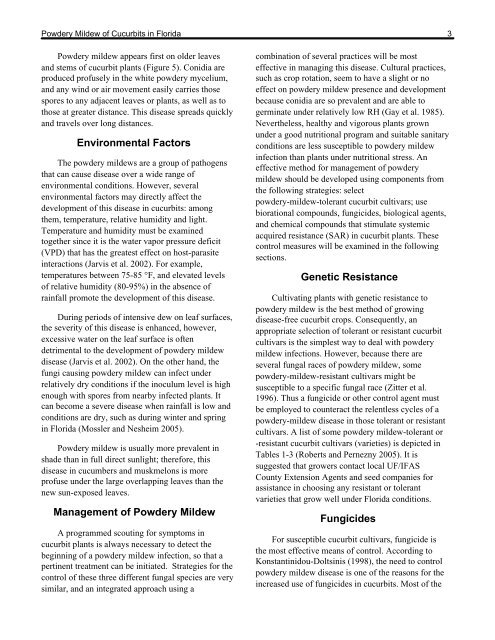Powdery Mildew of Cucurbits in Florida - Orange County Extension ...
Powdery Mildew of Cucurbits in Florida - Orange County Extension ...
Powdery Mildew of Cucurbits in Florida - Orange County Extension ...
You also want an ePaper? Increase the reach of your titles
YUMPU automatically turns print PDFs into web optimized ePapers that Google loves.
<strong>Powdery</strong> <strong>Mildew</strong> <strong>of</strong> <strong>Cucurbits</strong> <strong>in</strong> <strong>Florida</strong> 3<br />
<strong>Powdery</strong> mildew appears first on older leaves<br />
and stems <strong>of</strong> cucurbit plants (Figure 5). Conidia are<br />
produced pr<strong>of</strong>usely <strong>in</strong> the white powdery mycelium,<br />
and any w<strong>in</strong>d or air movement easily carries those<br />
spores to any adjacent leaves or plants, as well as to<br />
those at greater distance. This disease spreads quickly<br />
and travels over long distances.<br />
Environmental Factors<br />
The powdery mildews are a group <strong>of</strong> pathogens<br />
that can cause disease over a wide range <strong>of</strong><br />
environmental conditions. However, several<br />
environmental factors may directly affect the<br />
development <strong>of</strong> this disease <strong>in</strong> cucurbits: among<br />
them, temperature, relative humidity and light.<br />
Temperature and humidity must be exam<strong>in</strong>ed<br />
together s<strong>in</strong>ce it is the water vapor pressure deficit<br />
(VPD) that has the greatest effect on host-parasite<br />
<strong>in</strong>teractions (Jarvis et al. 2002). For example,<br />
temperatures between 75-85 °F, and elevated levels<br />
<strong>of</strong> relative humidity (80-95%) <strong>in</strong> the absence <strong>of</strong><br />
ra<strong>in</strong>fall promote the development <strong>of</strong> this disease.<br />
Dur<strong>in</strong>g periods <strong>of</strong> <strong>in</strong>tensive dew on leaf surfaces,<br />
the severity <strong>of</strong> this disease is enhanced, however,<br />
excessive water on the leaf surface is <strong>of</strong>ten<br />
detrimental to the development <strong>of</strong> powdery mildew<br />
disease (Jarvis et al. 2002). On the other hand, the<br />
fungi caus<strong>in</strong>g powdery mildew can <strong>in</strong>fect under<br />
relatively dry conditions if the <strong>in</strong>oculum level is high<br />
enough with spores from nearby <strong>in</strong>fected plants. It<br />
can become a severe disease when ra<strong>in</strong>fall is low and<br />
conditions are dry, such as dur<strong>in</strong>g w<strong>in</strong>ter and spr<strong>in</strong>g<br />
<strong>in</strong> <strong>Florida</strong> (Mossler and Nesheim 2005).<br />
<strong>Powdery</strong> mildew is usually more prevalent <strong>in</strong><br />
shade than <strong>in</strong> full direct sunlight; therefore, this<br />
disease <strong>in</strong> cucumbers and muskmelons is more<br />
pr<strong>of</strong>use under the large overlapp<strong>in</strong>g leaves than the<br />
new sun-exposed leaves.<br />
Management <strong>of</strong> <strong>Powdery</strong> <strong>Mildew</strong><br />
A programmed scout<strong>in</strong>g for symptoms <strong>in</strong><br />
cucurbit plants is always necessary to detect the<br />
beg<strong>in</strong>n<strong>in</strong>g <strong>of</strong> a powdery mildew <strong>in</strong>fection, so that a<br />
pert<strong>in</strong>ent treatment can be <strong>in</strong>itiated. Strategies for the<br />
control <strong>of</strong> these three different fungal species are very<br />
similar, and an <strong>in</strong>tegrated approach us<strong>in</strong>g a<br />
comb<strong>in</strong>ation <strong>of</strong> several practices will be most<br />
effective <strong>in</strong> manag<strong>in</strong>g this disease. Cultural practices,<br />
such as crop rotation, seem to have a slight or no<br />
effect on powdery mildew presence and development<br />
because conidia are so prevalent and are able to<br />
germ<strong>in</strong>ate under relatively low RH (Gay et al. 1985).<br />
Nevertheless, healthy and vigorous plants grown<br />
under a good nutritional program and suitable sanitary<br />
conditions are less susceptible to powdery mildew<br />
<strong>in</strong>fection than plants under nutritional stress. An<br />
effective method for management <strong>of</strong> powdery<br />
mildew should be developed us<strong>in</strong>g components from<br />
the follow<strong>in</strong>g strategies: select<br />
powdery-mildew-tolerant cucurbit cultivars; use<br />
biorational compounds, fungicides, biological agents,<br />
and chemical compounds that stimulate systemic<br />
acquired resistance (SAR) <strong>in</strong> cucurbit plants. These<br />
control measures will be exam<strong>in</strong>ed <strong>in</strong> the follow<strong>in</strong>g<br />
sections.<br />
Genetic Resistance<br />
Cultivat<strong>in</strong>g plants with genetic resistance to<br />
powdery mildew is the best method <strong>of</strong> grow<strong>in</strong>g<br />
disease-free cucurbit crops. Consequently, an<br />
appropriate selection <strong>of</strong> tolerant or resistant cucurbit<br />
cultivars is the simplest way to deal with powdery<br />
mildew <strong>in</strong>fections. However, because there are<br />
several fungal races <strong>of</strong> powdery mildew, some<br />
powdery-mildew-resistant cultivars might be<br />
susceptible to a specific fungal race (Zitter et al.<br />
1996). Thus a fungicide or other control agent must<br />
be employed to counteract the relentless cycles <strong>of</strong> a<br />
powdery-mildew disease <strong>in</strong> those tolerant or resistant<br />
cultivars. A list <strong>of</strong> some powdery mildew-tolerant or<br />
-resistant cucurbit cultivars (varieties) is depicted <strong>in</strong><br />
Tables 1-3 (Roberts and Pernezny 2005). It is<br />
suggested that growers contact local UF/IFAS<br />
<strong>County</strong> <strong>Extension</strong> Agents and seed companies for<br />
assistance <strong>in</strong> choos<strong>in</strong>g any resistant or tolerant<br />
varieties that grow well under <strong>Florida</strong> conditions.<br />
Fungicides<br />
For susceptible cucurbit cultivars, fungicide is<br />
the most effective means <strong>of</strong> control. Accord<strong>in</strong>g to<br />
Konstant<strong>in</strong>idou-Dolts<strong>in</strong>is (1998), the need to control<br />
powdery mildew disease is one <strong>of</strong> the reasons for the<br />
<strong>in</strong>creased use <strong>of</strong> fungicides <strong>in</strong> cucurbits. Most <strong>of</strong> the
















